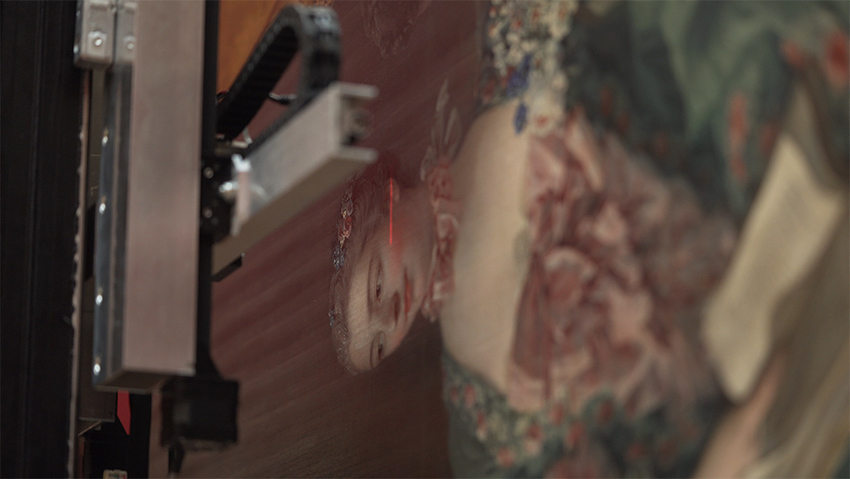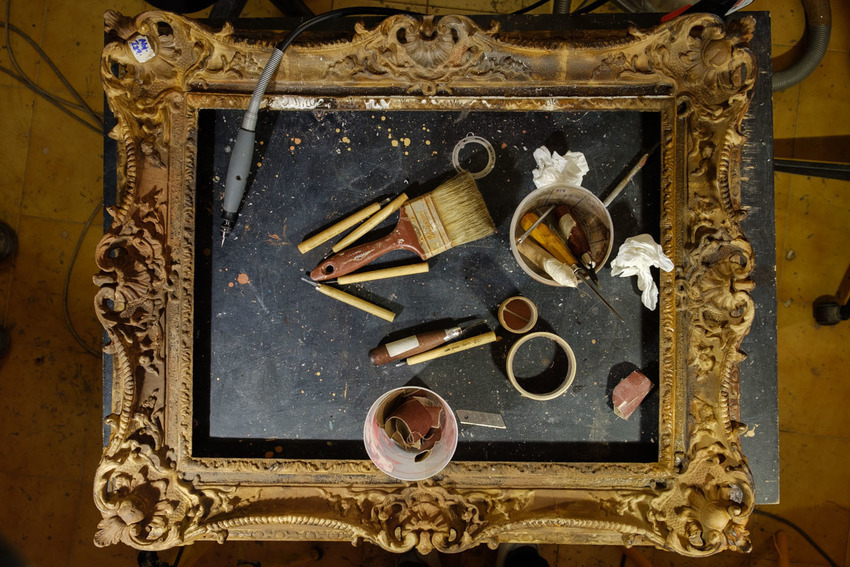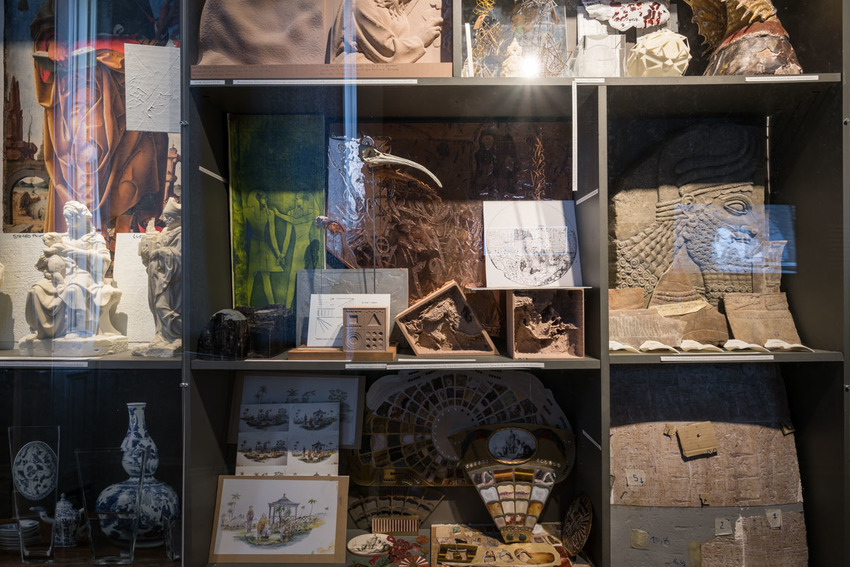The “private” lives of the pre-Revolution kings of France were a topic for public speculation even in their own time, and the Marquise de Pompadour, the erudite and powerful mistress of Louis XV, continues to fascinate to this day. One of the most famous images of Madame de Pompadour, as she is best known, is that painted by François Boucher, one of the leading figures of the French rococo style, in 1756, at the height of her influence at court. The painting was acquired in 1887 by Baron Ferdinand de Rothschild, a member of the famous financial dynasty and a collector with a particular passion for the arts of 18th-century France and the Ancien Regime, and was bequeathed after his death to his brother Nathaniel. It is now on display at the Alte Pinakothek in Munich, on permanent loan from its owner, the HypoVereinsbank, Member of Unicredit.
The facsimile created by Factum Foundation allows the Munich painting of Madame de Pompadour to take its place once again among Baron Ferdinand de Rothschild’s collections, and even in the mid-18th-century French frame (with 19th-century additions) which the painting occupied at that time. It is shown alongside a second facsimile, this one of a smaller Boucher oil sketch of Madame de Pompadour, purchased by Ferdinand’s cousin Baron Edmond (1878-1934). This painting is on loan from a Rothschild family trust, and its inclusion in the Waddesdon exhibition provides a rare opportunity to examine an original alongside Factum Foundation’s facsimile of it.
Recording at the Alte Pinakothek
The large canvas (201 x 157cm) was scanned in the galleries of the Alte Pinakothek in Munich. The Lucida 3D Scanner was used to capture the very fine surface relief of the large canvas – a process that took over twenty hours and required the scanner to be built up to its maximum 2m height. One of the reasons Factum produces such meticulous recordings even for paintings that at first glance appear to be lacking in interesting texture (Boucher’s paintings are relatively flat) is that an accurate scan of surface relief results in a far more naturalistic replica. Another reason is that high-quality data can be used to study the canvas and its conservation status in great detail.

Scanning the large portrait in the Alte Pinakothek © Óscar Parasiego for Factum Foundation
The colour of the Boucher's painting was recorded with panoramic photography, a technique in which the photographer takes multiple overlapping photographs of a surface at very high resolution from a fixed point. During post-processing a ‘mosaic’ is built up from the individual photographs to produce one very heavy image file; Factum Foundation is currently producing recordings of flat surfaces with resolutions up to 900dpi. In the museum, the process involves carrying out both physical and digital colour checking procedures: digital colour checks using X-Rite colour checking methods, and physical colour checks using Pantone 'colour sticks', which are matched to the colours on the painting by the human eye. These can be used at a later stage in post-processing to bring the digital colour file into even closer correspondence to the colours of the original painting.

Colour checking © Óscar Parasiego for Factum Foundation
Scanning the oil sketch of Madame de Pompadour and its frame at Waddesdon
Factum Foundation has also made a recording of the second Boucher painting of Madame de Pompadour. The small oil sketch was recorded in a day using the Lucida 3D Laser Scanner and panoramic photography, and the frame was recorded separately using photogrammetry. Photogrammetry involves taking multiple pictures of an object from different angles, and then converting them into a depth map using computer software; this results in a 3D model of the object. For the Waddesdon frame, 641 photos were used in order to construct the model.
Processing the data
The Lucida data was processed to produce “renders” of the surfaces of the paintings: 2D depth-maps, viewable on a computer browser, of the 2.5D reliefs, allowing the user to see changes in relief of the paintings’ surfaces. A separate colour file was produced for each painting, as well as a third file in which the colour was mapped onto the 2.5D render – an operation precise enough that each three-dimensional brushstroke corresponds to the correct colour. These three different datasets – render, colour, render + colour – were then gathered together into a layered archive, shown here, where they can be compared with one another and used by conservators and others to study the surface of the painting. These files also provide the raw material for the physical materialization of the facsimile.
Physical materialisation of the canvases
In order to make the facsimile, the surface relief of the painting was first printed in 3D using the elevated printing technology developed by Canon Production Printing (previously Océ), a Canon company with whom Factum Foundation has collaborated on many projects. CPP’s revolutionary printing method involves building up pigment layer by layer to create a high-resolution relief surface.
In Factum’s workshops, liquid silicon was poured over CPP’s print to create a mould of its surface, and a cast was made from this mould in acrylic-reinforced gesso. This “fiberskin”, which forms the base surface of the final facsimile, was then glued onto a canvas.
Factum’s unique flatbed printer, which has been adapted in-house for this purpose, was used to print the colour data onto the textured surface of the cast. The data is first printed onto a layer of acetate, which is then matched precisely to the fiberskin to ensure that the distribution of pigment corresponds precisely to the relief of the painting’s surface. A second printing stage takes place directly onto the relief surface. Finally, the canvas is varnished to match the finish of the original painting.
A first proof printout of the small facsimile was taken to Waddesdon to ensure that the colours match those of the original, allowing for adjustments before the printing of the final facsimile.

© Oak Taylor Smith
This sample, which will be shown in the exhibition, is a test done using Océ's Elevated Printing Technology which shows the surface data for the small painting, both with and without colour, reproduced at different depths of relief. The sections at the top have no relief at all, while the sections at the bottom have a far more pronounced relief than the original painting. While the colour for the actual facsimile was printed by Factum, recent advances in Océ's technology may provide alternative methods of rematerialising colour.

Final facsimile of Boucher's portrait © Oak Taylor Smith
Physical materialisation of the frame
The frame for the small facsimile was 3D printed in polyamide in several parts using stereolithographic printing (SLP). These parts, which are originally hollow, were then joined together and filled with epoxy resin for strength and solidity.
The framing re-materialisation processes employed by Factum Foundation involve the merging of traditional skills with innovative methodologies developed in response to the non-traditional materials with which we work; our expert gilding and patination experts have adapted existing gilding practice to allow gilding on surfaces as diverse as aluminium and polyurethane. For this frame, they began by coating the polyamide surface in gesso, and then added a second layer of bole (ceramic) before applying the gold itself. The frame was then polished and patinated.
As the original frame has been restored by Waddesdon in the period between our recording of it and the exhibition, Factum’s artisans have had to make decisions about how far to “restore” the facsimile as well: whether to fill in a crack on the pre-restored frame, for example, and whether to imitate the patination of the frame prior to, or after, restoration.

© Oak Taylor Smith

The finished facsimile and its frame © Oak Taylor Smith for Factum Foundation
The exhibition at Waddesdon Manor
The facsimiles are shown at Waddesdon in the exhibition ‘Madame de Pompadour in the Frame’, organised by Factum Foundation and Waddesdon Manor and designed by RIBA-award-winning architects Skene Catling de la Peña. Running from May 23rd to October 27th 2019, the exhibition allows visitors to examine the facsimiles alongside artefacts of the production process and to watch a video showing the various stages of making.
The exhibition design draws on the Rococo world of Madame de Pompadour as defined and championed by François Boucher, using a variety of digital techniques developed by Factum Foundation. A series of engraved Rococo panels by Boucher are printed onto silk and surrounded by bevelled mirrors. Originally intended for a folding screen, the themes are, ‘Rocaille (Rococo)’, ‘Leda’, ‘The Triumph of Priapus’, ‘The Triumph of Pomona’, and ‘Pastorale’. Boucher’s excessive allegorical imagery and visual puns, multiplied through reflection, creates a magical world that appears to extend far beyond the space of the exhibition. With an allusion to Versailles, this Hall of Mirrors creates its own infinity, reinforced by the secondary illusion of the rococo world seen through the frames of Boucher's architectural conceits.
On top of the wallpaper hang two framed versions of the small, spontaneous and intimate oil sketch by Boucher that is still in the collection at Waddesdon. One of these two is original. At the far end of the room hangs a copy of the finished painting of Madame de Pompadour from Alte Pinakothek in Munich – reunited with its 'original frame'. This juxtaposition challenges the visitor to reflect on the dynamic nature of all works of art and think about how objects age, migrate and how they are preserved.
A Lucida 3D Laser Scanner is set up in the main room to record various paintings in the Waddesdon collection over the course of the exhibition. In a separate part of the display, cases containing an extraordinary collection of objects from the Factum studio – a ‘Cabinet of Curiosities’ – show the fusion of technology and craftsmanship involved in Factum's work. Everything aims to reveal the process of recording and making, ‘input and output’, technology and material evidence.

Entering the exhibition galleries at Waddesdon Manor © Oak Taylor Smith for Factum Foundation




































